360 Apartment building + Giant Supermarket vs. a BP gas station, which would you choose?
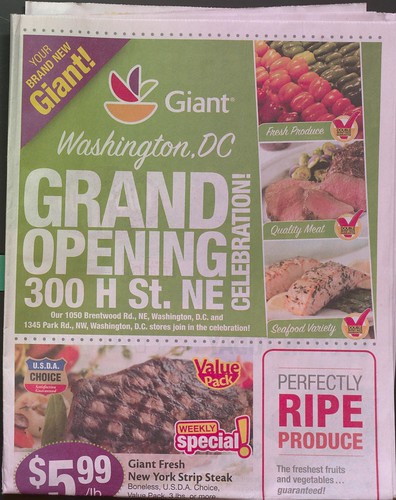
Yesterday was the grand opening of the Giant Supermarket on H Street NE.
In a first for Giant, the store is on the ground floor of a five story apartment building called the 360 Apartment Building, so it ends up being the first Giant Supermarket that is part of a residentially-focused vertical mixed use project (as opposed to "horizontal" mixed use where different uses are present, but in single use "servings" on an overall site).
In fact, residents of the building will have their own secure access elevator and entrance to the store.
(Giant will be opening two more stores in this kind of configuration elsewhere in the city, on 9th Street NW later this year, and on Wisconsin Avenue next year.)
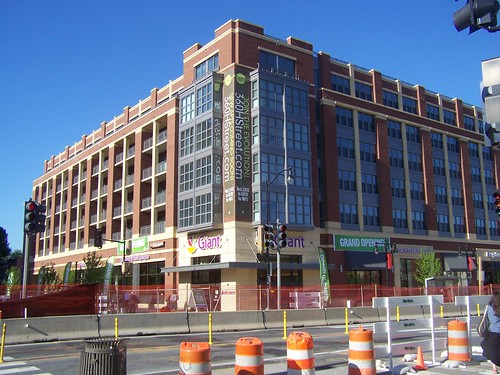
The entryway doesn't look so hot now (see image, right), but that's because the city is adding a streetcar stop to this corner--at the behest of the property owner and Giant--that's quite a difference from the debacle about 8 years ago, over the then new Giant Supermarket in Columbia Heights.
When the Tivoli Square store opened, Giant and the developer installed a "driving lane" on the sidewalk.
It took many months of effort (with some support from DDOT but with waffling by the Deputy Mayor for Planning and Economic Development, because they were negotiating with Giant to open a store in Ward 7's Congress Heights neighborhood and feared that Giant would back away from the W7 site), but the store and the developer eventually backed down and removed the lane, at the behest of neighborhood activists.
Ssee the past blog entries "Speaking of Pedestrians -- Protest Giant Supermarket's Taking of a(n Illegal) Curb Cut," "Urbanity, History and the Giant Supermarket at Tivoli Square" and "(Urban) Grocery Shopping."
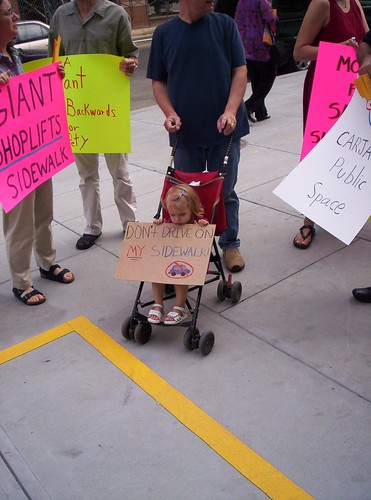 Now Giant has advocated for better transit access--look how far the city has come in 8 years!
Now Giant has advocated for better transit access--look how far the city has come in 8 years!But the 360 Apartment Building project is an example with many meta lessons and a demonstration of how long change can take.
1. Originally, this site was an Amoco gas station. It really sucked. People were murdered there most every year, there were robberies and other mayhem. It was a noxious use of the worst sort.
2. The business was managed poorly, albeit by an independent operator, but still I often wonder if this was deliberate.
3. Nuisance properties assist land assemblage programs.
By creating a hyper-noxious use (nuisance), most of the other buildings on the block became vacant as businesses closed, making it easier for BP (the successor company to Amoco) to buy and/or option adjoining properties for very little money.
BP was able to end up with control of about half the block, and in 2000 they announced plans to construct a new signature (for them) BP Connect gas station with a convenience store, car wash, and googaws on the pumps, of about 50,000 s.f.
Right: the first BP Connect stations were built in Australia.
4. A key lesson is that organized advocacy makes a difference.
It happens that this was the block that I first lived on when I moved to Washington in 1987, although by the time BP proposed this particular project, I lived a couple streets over.
And this proposal was the first civic issue that I really got involved in, having decided a few months before that if I didn't start getting involved in my neighborhood, H Street would continue to languish.
Many people were opposed to the station (see "Gas Attack: Stanton Park community groups take on a suburban-style mega station" from the Washington City Paper, 2001), and the galvanizing of that opposition in large part touched off the revitalization of H Street that we see seriously underway today.
But to BP, the BP Connect brand is essential to their market positioning and brand and is the ultimate expression of their business. This station would have been one of the first BP Connect stations constructed in the US. And they figured we'd be happy about the proposal, given how lousy the Amoco station was by comparison.
At that time, white people mostly lived south of H Street, and the Stanton Park Neighborhood Association was actively working to represent that side of the neighborhood's concerns about revitalization and disinvestment.
The north side of H Street was mostly African-American and the neighborhood organization on that side of the street, Near Northeast Citizens, was less well organized and resourced and was more focused on dealing with crime issues (it was on that side of H Street, a few blocks away, where one of the city's most successful crack dealing operations was based).
5. But without remedies and processes within the law to support your position, often civic action goes for nought. Without remedies--something you can do that is already part of the law and regulatory process--activism and "opposition" mostly remains inchoate and unsuccessful. Even if organized, such as the ability to sue, without standing and remedies, lawsuits fail too.
The reason that residents could fight off the gas station is that in DC's C2 commercial zoning classification (neighborhood abutting commercial district), gas stations aren't matter of right, approval requires a special determination and a hearing before the Board of Zoning Adjustment. This gave the community leverage in dealing with BP.
(It is because the historic preservation regulatory process provides remedies and a systematic process for citizen input into building construction and alteration in historic districts is why I became such a proponent of historic preservation in DC. It's one of the only opportunities that provides for regular citizen input in the building regulation system.)
6. Even so, without the support of the local government, it can be very difficult to win. Mayor Williams let the Office of Planning oppose the BP project. The "development review" report produced by the Office of Planning--such a report is a requirement of the hearing process--was not favorable, saying that better use for the site was possible.
Today, there is a five story apartment building on the site, adding 215 residential units (the building would have been another story taller but the real estate crash in 2008 diddled with financing), including a grocery store. And the building is reasonably attractive.
7. Especially because the opposition will work to co-opt other community organizations and institutions who are susceptible to "being bought off." While the immediate neighbors and the SPNA were united in opposition, BP gave a small donation to the Children's Museum and said they would have a solar canopy for the pumps, so the Children's Museum was supportive.
BP (really their attorney representatives, who know how to push and pull the right levers) got the H Street CDC on board and a putative community group, Linden Neighborhood Association, which represents a single block of the neighborhood and is ten blocks away.
A counter example in the same neighborhood: the Shell station on the 1400 block of Maryland Avenue NE
As a leftover of the post-riot H Street Urban Renewal Plan, the 1400 blocks of H Street and Maryland and Florida Avenues are zoned for higher density. Mostly this was to allow for the senior housing building Delta Towers. But with the apartment building exception, this particular block is comprised of two story buildings, but with C3 commercial zoning.
In the C3 zone, gas stations are a matter of right. There is no provision for a special hearing or determinations. Therefore citizens have no potential remedies at their disposal and are without a formal process for citizen input. Therefore they had no points of leverage with the property owner.
The only recourse was to work with the City Government to get something better.
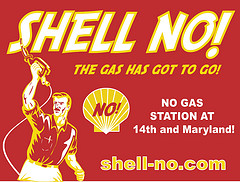 Residents opposed to the creation of a gas station on the site were out of luck--they had a great campaign--when the Fenty Administration and then Deputy Mayor for Planning and Economic Development Neal Albert showed no interest in assisting residents in working towards the realization of a better project.
Residents opposed to the creation of a gas station on the site were out of luck--they had a great campaign--when the Fenty Administration and then Deputy Mayor for Planning and Economic Development Neal Albert showed no interest in assisting residents in working towards the realization of a better project. (The control conditions were a little different from the BP site and less favorable to suasion. BP controlled the 300 block site on a long term lease, they didn't own it, whereas the 1400 Maryland Avenue NE site is owned by the gas station company that ultimately built the station.)
Interestingly, two of the corners at this intersection are "good," one a revitalized school now serving as an apartment building, and the old church across the street has been demolished in favor of a condo building, and two bad--the Shell station and a Checkers fast food store with a drive in window. Maybe over time with the addition of the new condo building, over a longer time frame, this site could change again.
But compare the 1400 Maryland site (Delta Towers is in the background) to 300-360 H Street NE.
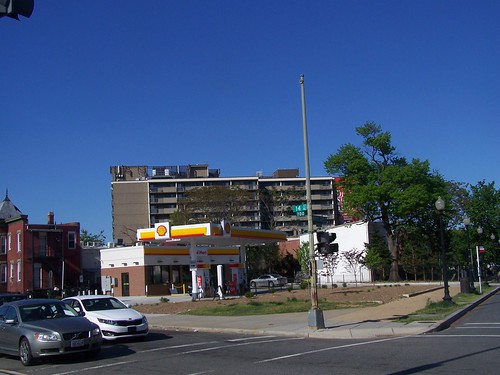
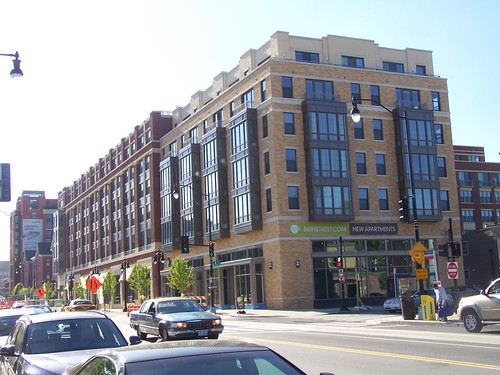
Sometimes community organization, consensus, and commitment isn't enough. You need remedies for sure, and with them you still need a supportive government because often a lot is left up to the interpretation of the law, and the lawyers representing the developers are well prepared to fight for the interpretation that favors their client.
Without remedies, you definitely need a supportive government, or you will lose (also see the Georgia Avenue Walmart issue; there also the Gray Administration was hyper-favorable to Walmart, making civic opposition ultimately unsuccessful).
8. But it sure helps to have a rebounding real estate market. When the BP station was first proposed, DC was just beginning to shake off the doldrums of a 12 year long real estate recession.
The election of Anthony Williams as mayor had just begun to change the investment climate in the city, but just barely. The city still had a hard time attracting new residents and municipal services had languished for a long time.
But real estate developers still needed more of an indication that H Street was a worthy place to invest, especially because it had been the domain of the H Street Community Development Corporation for more than one decade.
9. Plans and revitalization coordination organizations are essential to longer term success. Concern over the BP proposal brought both sides of the corridor together against a common foe and out of this effort H Street's current success was born:
- residents came together and in association with the H Street Merchants and Professionals Association, created the H Street Main Street community revitalization initiative, which began organizing in late 2001 and was chosen to be one of the city's first Main Street programs in April 2002.
- simultaneously, the city (at the behest of Councilmember Ambrose, a new Mayor, Anthony Williams, and a revitalizing Office of Planning, then under the direction of Andrew Altman) decided to invest in the creation of a new comprehensive revitalization plan for the H Street corridor.
The planning process was fast, it started in 2002 and wrapped up in 2003, and set the stage for the current improvements by focusing developer attention on the corridor by "reorganizing and focusing" attention on four different nodes.
The Main Street effort was necessary because the approach to revitalization on the corridor needed as serious reboot. (See "The community development approach and the revitalization of DC's H Street corridor: congruent or oppositional approaches?.")
And because change happens over extremely long time frames, you need a sustained effort over many years and subsequent political administrations.
10. It helps a lot to have an anchor developer enter and reposition the submarket for success and to reduce the risk for other entrants.
Eventually, you can argue that people and investors would see the merits of the H Street corridor given its proximity to Union Station and the creation of what is now called the NoMA Metro Station (which opened in 2004).
I won't get into what I argued back in 2003 was a major flaw in the plan, making the 200-700 blocks a "residential zone" rather than arguing for mixed use retail on the ground floor. At that time it was still believed that the biggest problem on the corridor was too much commercial space, when it was more about the type of space that was available as well as the need for more housing. But I always thought that proximity to Union Station was a huge asset for the eastern end of H Street, as it is proving out.
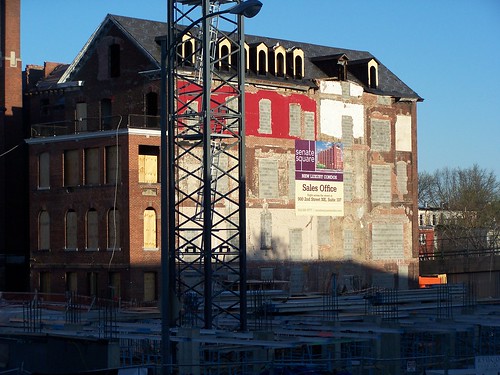 The plan did not foresee the Children's Museum decamping to Maryland, even though the planning consultants believed that a different location (such as next to the Postal Museum) would be better for them. For political reasons they never made such a recommendation.
The plan did not foresee the Children's Museum decamping to Maryland, even though the planning consultants believed that a different location (such as next to the Postal Museum) would be better for them. For political reasons they never made such a recommendation.But in 2004, Abdo Development announced an agreement with the Children's Museum to buy their one block site, and they restored the building as condos and built two apartment buildings with more than 400 units on the rest of the site. The complex opened in 2008.
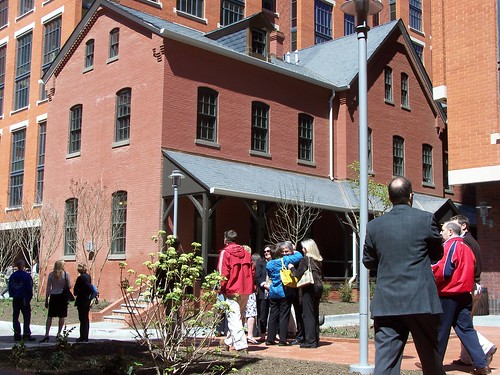 Right: grand opening day of Senate Square + Landmark Lofts. Shown is the amenities outbuilding on I Street with newly constructed multiunit apartment buildings in the background.
Right: grand opening day of Senate Square + Landmark Lofts. Shown is the amenities outbuilding on I Street with newly constructed multiunit apartment buildings in the background.11. But there is no guarantee that in the end you'll win and get a better project, but when it happens it's awesome.
In the meantime, the residents and BP and the BZA were grinding to a standstill.
The BZA didn't want to say no, just ordered BP to keep mediating with the residents. And eventually BP got fed up. They had no tolerance for different types of stations in their portfolio, it was BP Connect or nothing (which is why many of the former BP stations in the city have been converted to other brands).
That set the stage for the owner of the BP site, Steuart Investment, to recognize that there were better and more economically viable alternatives for the site. And they bought BP out of their lease, and began the process that ultimately resulted in the new building.
12. But it can take a very very very very very long time. From the time residents came together to fight the BP Connect proposal to the opening of the Giant Supermarket has been about 13 years. It's been even longer for the property owner, when you count their history with the previous gas station tenant.
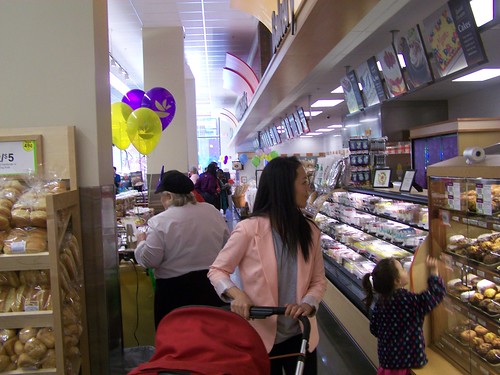
Baked goods and a child who wants a doughnut, Giant Supermarket, 300 H Street NE.
------------
I will probably write two more posts related to this, one about some ins and outs of getting the development to come to pass, and the other about Giant Supermarkets in the urban context.
Labels: civic engagement, commercial district revitalization, land use planning, participatory democracy and empowered participation, real estate development, supermarkets-groceries, urban design/placemaking, zoning




14 Comments:
Perhaps you mean first Giant in a vertical mixed use development in DC? Arlington has had the Penrose Square Giant for over a year now.
I've been wondering about the exxon in the west end on 22nd -- when that new luxury condo was built I was sure the exxon was going. But it was re-intregrated.
Beautiful structure, but only taxi drivers as clients.
But a great story, much appreciated.
As you know, Mayor Williams bought into Senate square. I looked at a unit there, beautiful, but I don't like H st st and the humpback bridge is a pain.
Great post. I had forgotten about the BP Station fight. It was a big win in and of itself, but the end product makes it all the more important. That new Shell station bums me out every time I pass it. Ugh! Your photo with Delta Towers in the background shows it in an especially bad light. I often wonder who owns the blighted properties on Maryland Avenue between the Shell station and the Argonaut. They are sitting on some potentially valuable property, even with the Shell station having gone in.
Chris S. -- oops. Yes, and clearly I don't have a full grasp of everything going on in Arlington.
charlie -- good point about the Exxon, I'll have to look into that more.
charlie -- I wonder if you made a mistake about Landmark Lofts... Over the next 10-20 years, H St. will shockingly become the most exciting neighborhood in the city. I'm sorry I don't own there now. In fact I was just thinking... if I win the lottery I better buy a place in Landmark Lofts first thing.
More on this later...
Richard -- agreed it has a nice future. In 5 years? 10 years? a bit more unclear on the timing.
In the meanwhile, I'd have to walk over that damn bridge everyday. Sorry, can't do it. Not a huge fan of U st but like being able to walk.
You should note Mayor Williams bought into H st.
I've thoroughly enjoyed reading your articles. Could you recommend any other good sites?
My Site -
Eco Innovations
yep, although he had been friends with Jim Abdo for awhile. I don't know how that stuff works, if there are "friends and family" deals like with IPOs.
True about the bridge but in 20 years (of course I'll be old then) it won't be like that.
And I just heard Whole Foods wants to go to 6th and H (with 1st and L as a back up).
I mean, this kind of stuff was completely unimaginable when we started HSMS.
And the streetcar likely will send things up another few notches...
"charlie -- good point about the Exxon, I'll have to look into that more."
The neighbors wanted one gas station remaining in the 'hood. Anthony Lanier of EastBanc charmed the feuding owners into selling him the property (which was M-O-R) in the West End and he put a green roof on top of the gas station to appease the tree huggers.
-EE
I got a photo yesterday of three people on that roof. DK why they didn't consider making the building bigger, and constructing over the canopy.
Probably not considered safe. But that's how things were done in the old days. Although I can't imagine people want to pay high end prices "to live over a gas station."
"DK why they didn't consider making the building bigger, and constructing over the canopy."
Am fuzzy on that, although it may have been more palatable to live next to the gas station rather than directly on top of it.
At his request, met with Lanier way long ago on the proposed project when just finishing my ANC adventure. Even though 22 West was M-O-R, he wanted our support because there had been such a negative public reaction to the Ritz PUD, EastBanc's first project in the West End.
IMHO, lot occupancy could be an issue in conjunction with the ridiculously out-of-scale relationship with the house abutting to the south.
As with the Ritz, the "penthouse" on 22 West is way too big, boring and downright ugly--it's actually a screen for a large pool--and can be seen from blocks away.
--EE
If I remember correctly, the 22W constructon had started, the gas station was still open for a bit, and then closed. I use the gym there across the street, so got to watch the construction. thanks for the backgrounding.
Richard, RE: H st, not trying to bash it, just saying it is a personal choice. I did got up though RFK yesterday, am was comparing it to walking home from a 96 soccer game at RFK. Amazing. Again -- cities have 30-40 year timespans.
"BP gave a small donation to the Children's Museum..."
In the late 1980s, I had been here a decade and my brother, his wife and two young kids came for a visit. I met up with them after they did a tour of the Capitol and we walked over to the Children's Museum which was a disappointing dump, although the kids made the best of it. And even though it was a beautiful late spring afternoon, as we were wandering around semi-lost, trying to find our way back to the Metro, I realized that I had better get us out of there quickly.
A good friend of mine--who has been politically active for most of his life--said to me years ago that he was amazed not by the fact that people could bought, but by how cheaply.
-EE
My joke is that the great thing about DC for developers is that we sell ourselves for so little. I used to say people sold themselves, but once I started blogging, and could be subject to libel charges, I referred to it as "green love."
Post a Comment
<< Home